This battle was fought the week before Christmas, but due to traveling and celebrating with family, the report is late. Our story left off with the Red Army reeling after two close defeats at the hands of the Army of the Five Rivers. The Red Army has retreated to the outskirts of the royal city and are making preparations for the inevitable invasion.
The Army of the Five Rivers' Light Column and an untested standard column would fight for the Rivermen. One of the irregular units in the light column enters the battle weakened from previous actions. Their general, having successfully masterminded two victories, has gained enough experience to shake his incompetencies in command.
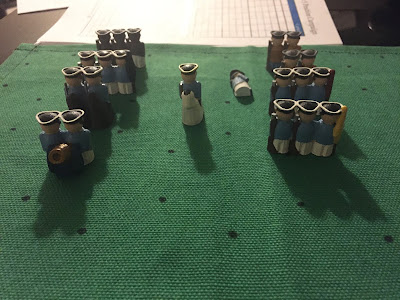 |
| The Kingdom of Five Rivers' Order of Battle |
The Red Army was able to replenish all of their existing units with motivated patriots from the Royal City. Their eliminated units were not able to be reinstated and the cavalry column would fight without one of its regular cavalry units.
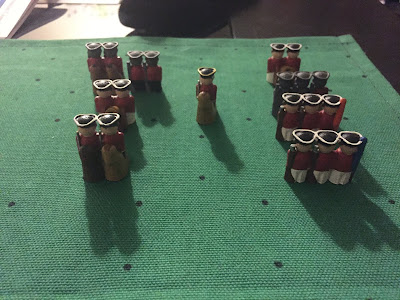 |
| The Red Kingdom's Order of Battle |
The two forces met along a bend in the central river. A significant hill and village fortified the inside of the bend, while a wealthy orchard stood out against the otherwise level field of the outside bend.
 |
| A field just outside the Red Kingdom's capital |
The Red Army took up a position on the hill on the outside bend, while the Rivermen race to take cover in the orchard and use the river to anchor their flank.
 |
| Positions at the end of Turn 1 |
The Red Army took advantage of its superior mobility and attempted to encircle the Rivermen as they advance to take the orchard and the buildings. The Red cavalry took fire from the irregulars in the orchard.
 |
Positions at the end of Turn 2
|
Both sides bombard the other to no effect. The Red Infantry was able to anchor its right flank on the bend in the river and exchanged volleys with the enemy infantry garrison in the farmhouse. Both sustained significant damage, but the Rivermen Infantry's morale was bolstered by the sight of their general and they retained their composure. The Highlander unit in the orchard continued to fire on the Red Cavalry, pushing them back.
 |
| Positions at the end of Turn 3 |
The Red Army's dragoons moved into the village inside the bend, leaving their horses to take up defensive positions in the buildings. This put the dragoons in position to fire on the artillery across the river. The regulars on the line of battle continued to exchange volleys. The Red Army's regulars fled as their ranks splintered. The militia next to the fleeing regulars panicked and lost their sense of order. The Rivermen line suffered losses on their left flank as well.
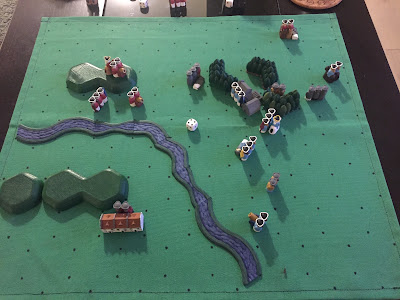 |
| Positions at the end of Turn 4 |
Seeing the Red dragoons in the village the Rivermen artillery unit redirected its fire and began bombarding the village, causing disorder in the ranks of the dragoons. En masse, the Red Army panics. Each of its units fail to inflict serious damage on the enemy. The cavalry on the flank reposition themselves towards the hill as the Red General attempts to rebuild a line with the elevated artillery position in the center. The artillery unit in the lowlands was forced to move away from fire and was forced into the ford. They were able to limber their guns and bring them with them.
 |
| Positions at the end of Turn 5 |
The Red General became overwhelmed with his troops positions and hesitated. Fortunately for him, the artillery colonel did not lose his nerve and was able to direct his battery to deliver a punishing blow to the main line of the Rivermen, causing the disordered regular unit to retreat. The highlander unit in the orchard advance through the treeline to engage the Red army as it consolidated its position around the small hill. The artillery unit forced into the ford was able to establish a hasty position, but the gunners were disordered.
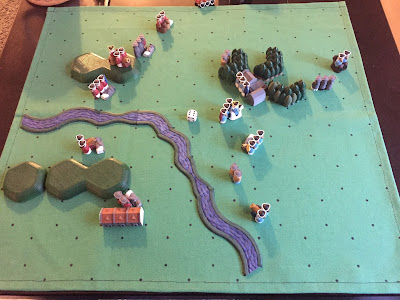 |
| Positions at the end of Turn 6 |
Their seemed to be a lull in the battle as only the artillery played a decisive role as the infantry on both sides rested. The Riverman battery forced the dragoons in the village to retreat as their reinvigorated cavalry charged the highlander unit in the orchard, but were slowed by the dense plantings. The highlander unit held the orchard with minimal losses.
 |
| Positions at the end of Turn 7 |
The otherwise uninvolved Noble Cavalry of the Rivers seeing that the battle may end without their involvement charged forward to engage the Red Cavalry, but they were forced back under targeted fire from the orchard. The Red Army's general began attempting to rally his flagging troops instead of ordering further attacks.
 |
| Positions at the end of Turn 8 |
The General of the Five Rivers ordered his line infantry forward to attack the exposed Red Cavalry. After the Noble Cavalry of the Five Rivers and the exhausted highlander unit in the orchard failed to route the Red Cavalry, the line infantry was ordered to turn to face the cavalry. They delivered a fatal volley causing the Red Cavalry to flee the field. The regulars of the Red Army fire and advance between the river and the hills.
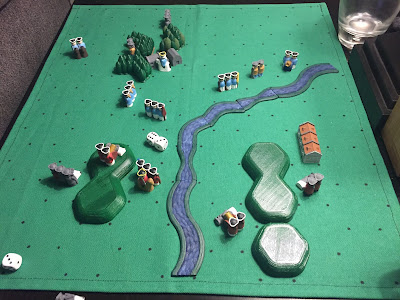 |
| Positions at the end of Turn 9 |
The Noble Cavalry and Rivermen Infantry continued their advance to assault the hill. The Red Line pivoted to meet the threat. The artillery on the hill and the regulars missed their target. The Rivermen pushed forward towards the hill, ready to end the battle with a decisive bayonet charge.
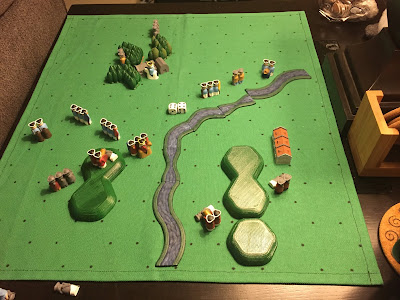 |
| Positions during Turn 10 |
The Noble Cavalry in an act of self aggrandizement charged the militia band to the right of the hill, routing the untrained and terrified troops. The regulars assaulted uphill towards the Red battery, forcing them to withdraw to the far side of the hill. From their new position, they would have a good shot at any enemy that attempted to use the ford. This position allowed the regulars and general to flee across the river under a hail of gunfire to mount a last stand inside the bend rallying the dragoons.
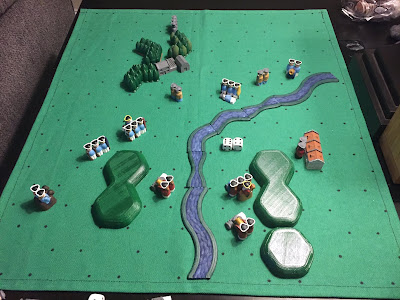 |
| Positions at the end of Turn 10 |
The battle ended as the battery outside of the bend was overran. The Red Army surrendered with all of its remaining units disordered. In their last stand, they were able to cause disorder in one of the regular infantry units.
 |
| Positions at the end of Turn 11 |
The Red King's army has been defeated in the field. After the conclusion of the battle, negotiators met on the River King's palatial barge to work out a peace treaty. The Red Kingdom will surrender its northern territorial holdings to the Kingdom of the Five Rivers. Furthermore, the Red King was forced to admit to plotting the murder of the The King of the Five Rivers and creating the succession crisis that caused the war.














